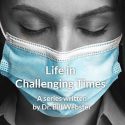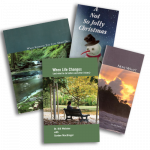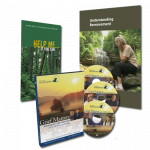A few months ago, I attended a conference in Stratford-on-Avon, the English town where William Shakespeare was born and lived. In the centre of the town stands a prominent statue of the bard himself. Surrounding the plinth are placed other effigies of some of the most famous Shakespearian characters … including a haunting one of Hamlet with the skull of Yorick in his hand, contemplating death.
Hamlet’s most famous soliloquy, “To be or not to be” is really all about death and life, and the choice that the suicidal Hamlet was making. Would a grief counsellor have helped Hamlet? Perhaps so, but it is difficult to see how even the great Shakespeare would have been able to make a good play out of the sessions they might have had!
But, “to be or not to be.” That is indeed the question!
I am coming to realize that “grief counselling” should really be “life counselling” … how to make the best of life whatever the situation we find ourselves in. Everyone faces struggles in life. The question is not about how many difficulties or struggles we may have; the issue is what we do about it.
Do we, in Hamlet’s words, “suffer the slings and arms of outrageous fortune” OR (and this is the choice) “take arms against a sea of troubles and by opposing, END THEM.” This is the choice that confronts people after a loss as they grieve what is missing and look for reasons and resources to be able to live their life. The choice to go on or to give up.
Sadly, Hamlet, as we all know, was not able to find these ways and means, and that is what makes the play a tragedy.
So, all of us have to ask the question, “To be or not to be.” We may be tempted to think that the question is “What do I have to DO to make life successful and worth living?” But I am not sure that is the right question. What do I have to BE (or not to be) to make it work?
1. BE CREATIVE
Whether in the workplace or at home, one of the secrets of breathing life into relationships or any situation is creativity. Make home life fun, interesting and productive. While risking a TMI (Too Much Information) moment, I have a friend who came home from work one Friday evening, and was greeted at the door by his wife, scantily dressed in a French maid’s outfit, inviting him to come in and enjoy the lovely dinner she had prepared. Needless to say, they had an interesting and enjoyable weekend, thanks to her being creative. (I must let my wife proof-read this article!!!) What could you do to spice up your relationship with your partner or with the kids on special days and so on? To be, or not to be?
Now while cautioning careful consideration about how to apply this principle to staff meetings or customer relations, what could you do to “Be Creative” in how you conduct your relationships with employees, or how you cultivate your reputation in the community. What can you do to stand out from the crowd? To be, or not to be?
Easier said than done? Sure. As professionals, I think we have to live the caregiving day in small increments, early morning, mid-morning, afternoon, evening, etc. Avoid looking at the entire day which looms ahead, which can look like SO much to do and to be. Create and appreciate small successes.
We have to live one day at a time, and one moment after another. I love the statement, “There is to be no weeping for the past, no longing for the future. This is how it is RIGHT NOW! Live it. Breathe it. Accept it. Dance with it. Wrap your arms around it in a loving embrace.”
2. BE A COMMUNICATOR
Communication always involves a message, or the substance of what we want to say, and a method, referring to the ways in which the content of that message is conveyed. The greatest thing in communication is not what you say, it is how you listen. Unfortunately for many of us, this is not an innate skill, but a learned behaviour. Learn to listen, not just with your ears, but with your eyes, face and other body language about which we spoke in an earlier article.
Learn to speak clearly, with honesty and kindness. Put yourself in the shoes of someone who is ill or who has experienced bereavement, or who needs your help. What would you want, need, and long for in a situation like that? As the poet says: “Speak of love to those who await your tenderness and your touch. Speak of faith and hope and joy to those who await your encouragement. Speak of kindness and understanding to those who await your compassion.”
Be respectful. Everybody’s different! Each one has their own perspective and world view
Practice being understanding and compassionate. A nursing colleague of mine made the following insightful statement at a workshop:
“It was a gigantic day for me when I decided not to question or resent the bell that summoned me to the sick room, but to simply answer. It was one small way I could live in compassionate service to another human being. This realization came about when I put myself in my patient’s shoes – or in their sick bed, to be more specific! What if I could not get up without help? What if I needed some water, some food or just some companionship?”
She made a choice every time she answered the call: to BE or not to be
3. BE CONTENT
I had the privilege of conducting a funeral last month, the 38 year old daughter of a lady who has been a colleague and friend of mine for years. It was a tragic circumstance. A few years ago Michelle was diagnosed with cancer, and the disease made a slow but inexorable journey through major organs ending up in her brain.
So where is “to be or not to be” in a situation like that. Actually it is a crucial part of the situation. She did not have a choice about overcoming her disease, it is true. But she did make a choice about what she was going to do with however many days she had left. She did more living in the last 18 months of her life that some of us do in a long lifetime, including a hot air balloon ride, travel trips with her mother, high tea at a fancy restaurant with her friends and family and many other things. Here are some of them:
“Michelle was always there to celebrate our victories with kind words, a bottle of wine and wonderful meals. She was a “foodie” who always knew about a new restaurant to enjoy. When nursing at the General Hospital she transformed the paediatric floor into an underwater world by spray painting the walls with a mural in a rainbow of colours. The kids were delighted. Michelle enjoyed photography. She could capture a child’s smile with ease, made lizards look lovely, made wild mushrooms and fields of weeds look magical.
Over the years, she also taught us the beauty of wrapping a gift for someone you love. She carefully selected baubles, feathers and bows to adorn her packages. Simple things that mean so much; Michelle was good at that.
She spent countless hours teaching our children crazy crafts, how to recycle odds and ends into treasured Christmas angels, painting dolls beds and transforming tool boxes into art caddies. She always made us remember the joys of being like kids and having fun.”
One of the last things she said in the hospice was “It is what it is, we just need to get on with it.”
That’s answering the question, “To be or not to be.” As Michelle said, “It is what it is,” and then she found ways to make the most of what she had left, and to be content with that. She discovered that death is not the ultimate defeat. A life that is unlived is an even greater tragedy.
After a loss, grieving people find themselves asking, ‘To BE or NOT to be.” Every day we have to find answers. Life is always about choices. A good life is not so much about life itself, as the way we allow ourselves to be affected by whatever life brings. The assessment of ‘good’ or ‘bad’ should not depend on circumstances. There are people like Michelle who seem to face all kinds of adversity, but never lose the spirit of determination linked closely to an attitude of gratitude.
So take a look at YOUR life today, your relationships, your involvements, and ask yourself, ‘To be … or NOT to be.” Only you can decide.








